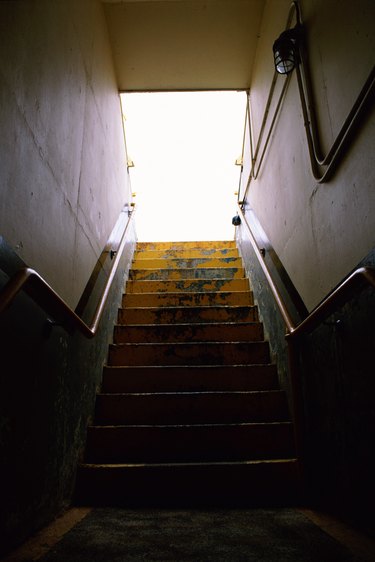
If you're remodeling a basement and adding a separate outside entrance, you might want to eliminate the stairwell that leads from the main floor to the basement. Closing off a stairwell is a matter of installing joists in the floor opening of the same dimension as the existing floor joists. In most cases, you can install new floor joists and remove the steps leading to the lower level. You might not be able to remove a wall on either side of the stairs, however.
Tear Out
Video of the Day
Before you can close off the stairwell, you'll have to remove anything that's in the way of the new framing. This includes the drywall on the insides of the stairwell, wood trim, and the tread on the first step and the upper two stair risers. The goal is to remove all stair parts above the bottom level of the floor joists so that they don't interfere with the installation of new floor joists in the stairwell opening. A reciprocating saw and a flat bar are necessary for removing the old stair structure.
Video of the Day
Load-Bearing Walls
Depending upon the staircase, there might or might not be walls along the sides of the steps. If there are walls, one might be load-bearing. A load-bearing wall serves as a support to carry the weight of the house above. It isn't always easy to determine if a wall is load-bearing, but there are some standards. If one of the walls is directly below a wall on the upper floor, it might be load-bearing. This configuration might occur if the entrance to the stairwell runs beside an upper floor wall. If the wall runs perpendicular to the floor joists, or if the wall runs down the center of the home, those are additional signs that it might be load-bearing. While you can remove non-load-bearing walls and the steps that attach to load-bearing walls, do not tear out a load-bearing wall unless an engineer first makes provisions to transfer the weight load.
Floor Joist System
Once the upper step is out of the way, it's time to build the new floor in the stairwell opening. This involves cutting and installing floor joists of the same dimension as the existing floor joists. For example, if the rest of the floor joists are 2-by-10s, you'll need to install 2-by-10s for the new joists. The floor opening will already contain headers that span the distance between the joists on the sides, and it will probably have double joists around the stairwell frame as well. These remain in place, and the new joists install to match the existing joist configuration. Each new joist should align with the existing joists on both sides of the opening. Use joist hangers, which are metal reinforcement plates, to support the ends of the new joists where they attach to the old frame.
Finishing the Project
A new section of subflooring is cut to fit the stairwell opening. Subflooring is a wood fiber sheet product that comes in 4-by-8 panels. On new floors, the subflooring connects by way of screws and subflooring glue, but it also features tongue-and-groove edge assembly. Since you're patching subflooring in the middle of the room, you'll have to cut the tongue edge off the subflooring panels. Butt the panel edges tightly together so the new subfloor is level with the old subfloor. Use wood screws to attach the subflooring to the new joists. For a finished look, install new carpeting or finish flooring to erase all signs of the old stairwell.